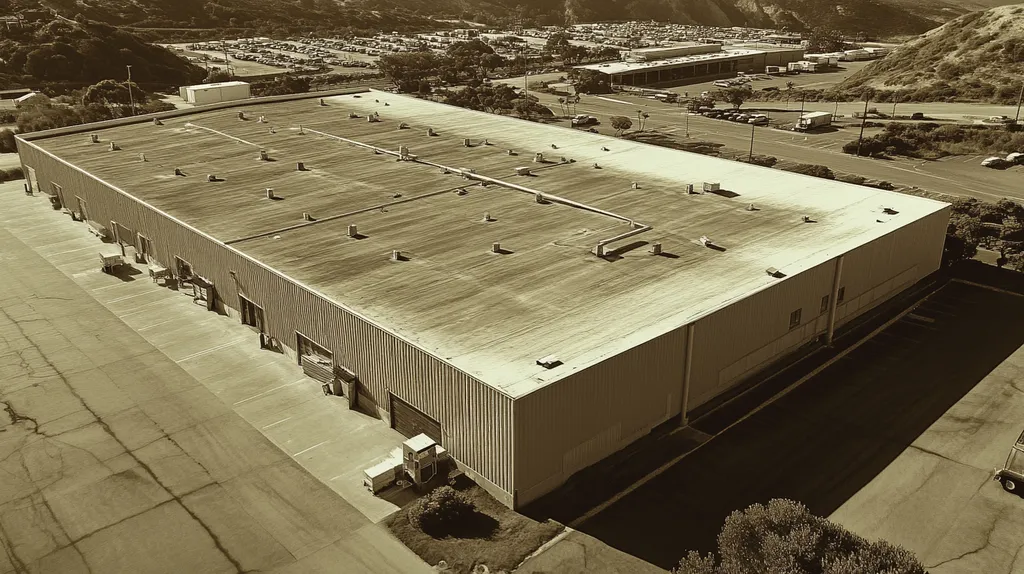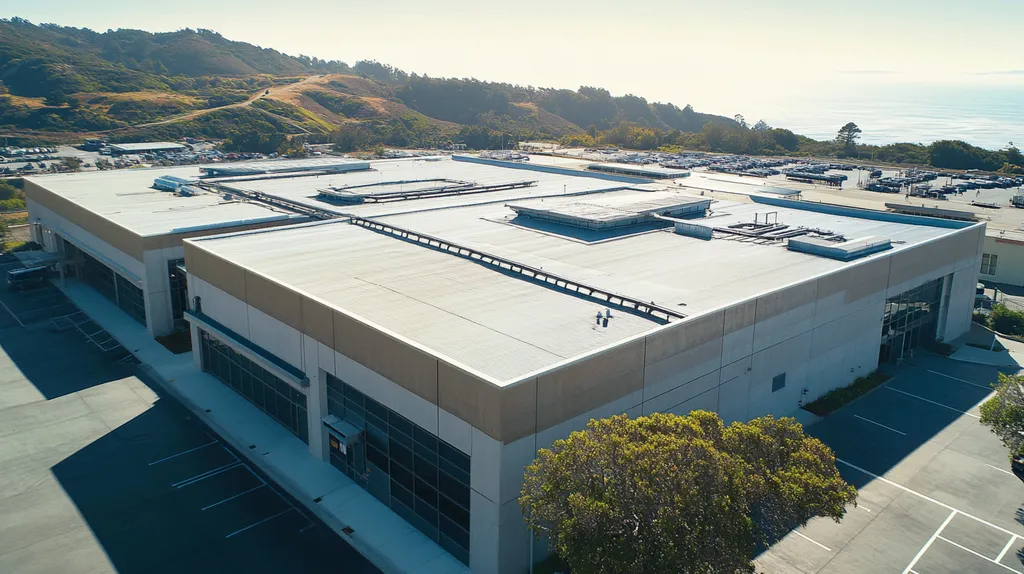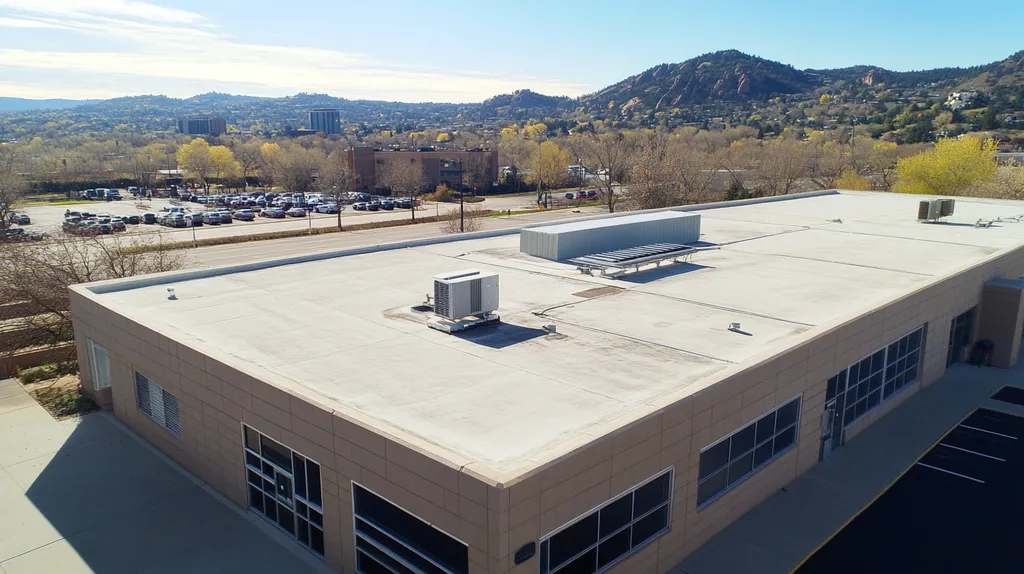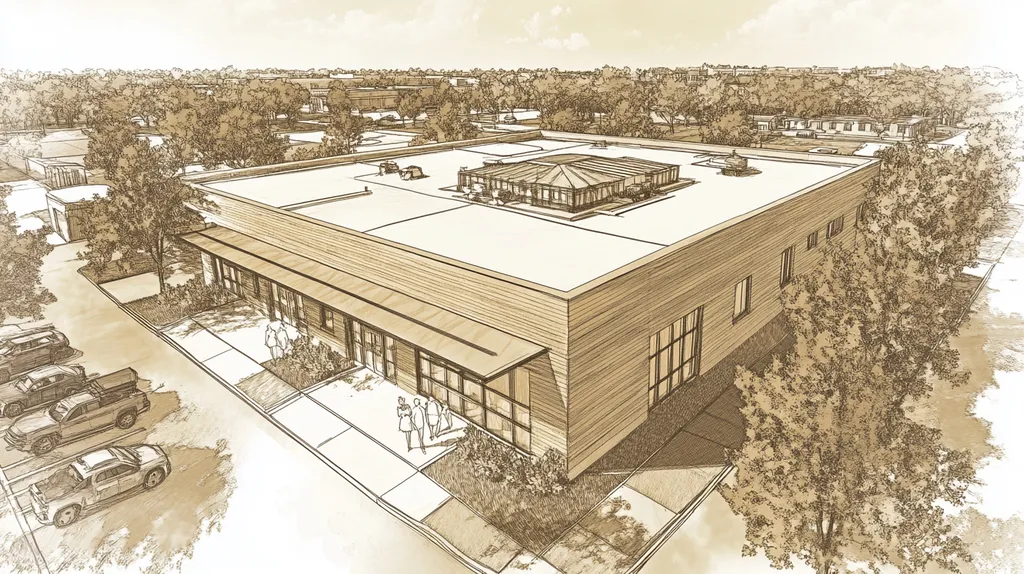Industrial facilities face mounting challenges as extreme weather events increase in frequency and intensity, with over 40% of commercial roofs experiencing significant damage during severe storms.
The financial impact is staggering – weather-related roof failures cost U.S. businesses more than $2.5 billion annually in repairs, inventory damage, and operational disruptions.
For facility managers, ensuring roof durability requires a comprehensive approach spanning material selection, maintenance protocols, and compliance standards. This actionable guide examines critical factors affecting industrial roof performance and provides detailed checklists for maximizing weather resistance.
SECTION 1: PERFORMANCE FACTORS
As severe weather events increase in frequency and intensity, the durability of industrial roofs becomes more crucial than ever for facility managers. Just one storm can lead to significant damage and costly interruptions, making the right choice of roofing materials and maintenance practices essential. Property owners must carefully consider material options, conduct roof integrity assessments, and employ effective waterproofing techniques to ensure their roofs are well-equipped to endure the elements. This section highlights the critical performance factors that enhance industrial roof resilience against extreme weather conditions.
Material Selection for Extreme Weather Durability
The roofing material selected has a profound impact on an industrial roof’s ability to withstand severe weather challenges. For example, thermoplastic roofs, such as TPO and PVC, offer outstanding resistance to the harmful effects of UV rays and ozone. These materials are engineered specifically to endure high winds and thermal expansion, common during extreme weather.
Moreover, metal roofs provide exceptional durability and longevity, especially in regions with significant rainfall or hail. Their resistance to rust and corrosion is essential, enhancing both performance and lifespan.
Using high-quality materials tailored for specific climate conditions not only ensures immediate protection but also reduces long-term operational costs. Facility managers must weigh the upfront investment against potential savings in repairs and energy expenses.
Key Action Items
Assessing Roof Integrity and Weather Resistance
Regular assessments of roof integrity are essential for identifying potential weather-related vulnerabilities. Routine inspections should focus on locating cracks, leaks, and other signs of wear that could threaten performance. Catching these issues early can save facility managers from expensive repairs later.
Understanding how well a roof can resist weather damage can also be enhanced through advanced testing methods like infrared thermography, which identifies moisture within roofing systems. This technology helps facility managers find hidden problems before they escalate.
Maintaining a robust schedule of inspections is crucial. Documenting findings allows for effective tracking of the roof’s condition. This proactive strategy enables informed decisions regarding necessary repairs or eventual replacements.
Key Action Items
Enhancing Roof Flexibility and Waterproofing
Flexibility in roofing materials is vital for accommodating the expansion and contraction that occur with temperature changes. Low-slope roofs, common in industrial settings, require materials that can adapt without cracking or degrading.
Utilizing advanced waterproofing systems, such as liquid-applied membranes, can significantly bolster defenses against leaks. These systems create a seamless barrier and provide the flexibility that traditional methods often lack.
Furthermore, ongoing maintenance of waterproofing solutions is necessary to ensure they function optimally. Special attention should be given to seams and flashings, as these are frequent failure points in roofing systems.
Key Action Items
SECTION 2: FINANCIAL CONSIDERATIONS
The integrity of an industrial roof is not just about protecting assets—it’s a critical aspect of financial management. Research shows that poor roofing can lead to a loss of up to 20% in operational efficiency. By selecting durable roofing materials and planning for weather-related repairs, facility managers can strategically drive long-term savings while boosting performance. This section investigates the financial aspects of roofing choices, including material costs, maintenance budgeting, and potential energetic savings.
Cost-Benefit Analysis of Durable Roofing Materials
Choosing durable roofing materials may involve higher initial costs, but the eventual savings and benefits usually justify these expenses. For instance, high-performance membranes can last up to 30 years compared to traditional materials that might need replacement within a decade.
When facility managers analyze lifecycle costs, they can reveal significant savings from reduced repairs and replacements. Sturdy roofs, designed to resist extreme weather, help minimize damage and lower associated costs.
In addition, opting for energy-efficient materials can profoundly affect operating budgets. These materials offer superior insulation, which results in decreased heating and cooling expenses in the long run.
Key Action Items
Budgeting for Maintenance and Weather-Related Repairs
Effective budgeting for maintenance plays a crucial role in prolonging the life of industrial roofs. Many facility managers fail to prioritize scheduled inspections and repairs, resulting in costly neglect.
Allocating a specific budget for maintenance can prevent unexpected expenses due to severe weather impacts. For instance, a pre-storm season inspection can identify vulnerabilities, like worn seams, allowing timely repairs.
Addressing weather-related repairs promptly not only curtails disruptions but also prevents productivity losses. Integrating weather forecasts into maintenance planning enhances readiness, enabling swift actions that protect both the roof and the bottom line.
Key Action Items
Long-Term Energy Savings and ROI on Roof Upgrades
Investing in roof upgrades often yields substantial returns, especially with energy-efficient materials. Advanced roofing technologies are engineered to reflect sunlight and enhance insulation, resulting in lower heating and cooling demands.
Facilities that switch to cool roofing systems, for example, have reported energy savings ranging from 10-30% annually. These savings can translate into thousands of dollars over time, particularly for larger properties.
Moreover, many energy-efficient roofing solutions may be eligible for government rebates or tax incentives, enhancing the ROI. By strategically investing in roof upgrades, facility managers can strengthen their infrastructure while unlocking potential savings for reinvestment.
In conclusion, addressing the financial considerations of roofing choices is vital for long-term sustainability and operational efficiency.
Key Action Items
SECTION 3: COMPLIANCE REQUIREMENTS
As extreme weather events become more frequent, compliance with building codes for weather-resistant roofs is essential. Facilities that fail to meet these codes not only risk significant damages but also jeopardize the safety of their occupants. Alarmingly, nearly 30% of facility owners are unaware of current compliance regulations. This section underscores the critical compliance aspects every facility manager needs to master.
Understanding Building Codes for Weather-Resistant Roofs
Building codes serve as the foundation for minimum safety and performance standards, especially for roofs. They stipulate materials, construction methods, and design specifications to ensure resilience against environmental challenges. For example, a facility located in a hurricane-prone zone must utilize roofing materials that adhere to specific uplift resistance requirements.
Local building authorities may impose additional regulations tailored to regional environmental conditions. Non-compliance can result in serious safety risks and legal consequences. Facility managers must routinely review these codes to ensure their roofs comply or exceed the established standards.
Staying updated with changes to building codes is also critical. These regulations can evolve due to advancements in technology or shifting environmental conditions. Regularly training staff and consulting with licensed roofing professionals is key to maintaining compliance.
Key Action Items
Fire and Wind Resistance Certification Standards
Fire and wind resistance certifications are critical for industrial roofs and play a vital role in safety and insurance costs. Many roofing systems must comply with testing standards set by organizations such as Underwriters Laboratories (UL) and the American Society for Testing and Materials (ASTM). For instance, a roof rated Class A for fire resistance can withstand intense fire exposure without igniting.
Wind resistance standards can vary by region, yet they are crucial for overall roof performance. Roofing materials should be tested for their ability to withstand strong winds, particularly in areas susceptible to hurricanes or tornadoes. Familiarity with these certifications allows facility managers to choose the right products, reducing the risk of wind damage and enhancing safety.
Neglecting to use appropriately certified roofing materials can lead to serious consequences, including heightened liability and increased insurance premiums. Regular reviews of fire and wind resistance standards are essential for making informed decisions.
Key Action Items
Environmental Regulations and Roof System Approvals
Environmental regulations are increasingly shaping roofing choices, particularly concerning sustainability. Many jurisdictions enforce compliance with specific environmental standards related to energy efficiency and low-emission materials. Following these regulations can lead to significant energy savings and a reduced environmental footprint.
Additionally, certain roofing systems require approvals from environmental agencies before installation. This ensures that selected materials and methods meet environmental standards, vital for facilities aiming to lessen their carbon footprint.
Non-compliance can result in fines and operational restrictions, highlighting the importance of understanding local environmental laws. Managers should also stay informed about evolving regulations, as changes may necessitate retrofitting existing roofs.
Key Action Items
SECTION 4: RISK MANAGEMENT
Managing the risks associated with extreme weather is essential for the longevity and effectiveness of industrial roofs. Facility managers face the challenge of preventing damage that can disrupt operations and incur significant costs. The National Roofing Contractors Association reports that nearly 80% of commercial roof failures arise from inadequate maintenance and weather-related factors. By identifying potential weather-related risks, conducting regular inspections, and establishing emergency response plans, facility managers can protect their investments and ensure roof durability.
Identifying Weather-Related Roof Failure Risks
Understanding the risks associated with extreme weather is vital for protecting industrial roofs. Heavy snowfall, strong winds, and heavy rain can all jeopardize roof integrity, leading to leaks or structural damage. For example, ponding water from inadequate drainage can weaken the roof material over time.
Facility managers should take local weather patterns into account to assess vulnerabilities. Roofs in hail or hurricane-prone areas must be designed with specific materials able to withstand such conditions. Conducting a thorough risk analysis helps identify these challenges and prepares managers for potential weather-related failures.
Utilizing advanced weather monitoring tools can enhance risk assessment. Real-time data on environmental conditions enables proactive measures against impending weather threats. Additionally, studying historical weather events allows for better forecasting and informed decision-making about roof maintenance and upgrades.
Key Action Items
Implementing Preventative Roof Inspections and Monitoring
Regular roof inspections are crucial for identifying potential risks and ensuring a durable roofing system. Industry standards recommend inspecting roofs at least twice a year, as well as after significant weather events. These inspections help uncover early warning signs of damage, such as cracked seams or deterioration.
During assessments, focus on areas commonly affected by weather, like roof penetrations and flashings. Utilizing tailored checklists can ensure thorough evaluations and prompt attention to potential issues. This proactive approach enables facility managers to address problems before they escalate into costly repairs.
Incorporating technology in inspections can enhance accuracy. Drones offer a safe and efficient way to survey roof conditions, while advanced imaging technology helps identify hidden problems that may not be visible to the naked eye. This level of monitoring significantly improves the long-term health of the roof.
Key Action Items
Developing Emergency Response Plans for Roof Damage
A well-constructed emergency response plan is crucial when roof damage occurs due to extreme weather. Facility managers need a clear protocol outlining the immediate steps to take, including assigning responsibilities and establishing communication channels for stakeholders. This ensures quick and efficient action during emergencies.
Safety is paramount; staff should be trained on procedures to follow during severe weather events. Regular drills can reinforce readiness and reduce confusion in high-pressure situations. Prompt action minimizes damage and operational disruptions.
Additionally, maintaining a list of reliable roofing contractors expedites repair processes. Quick response to roof damage can save costs that might arise from prolonged exposure to adverse weather conditions. Having trusted professionals ready to mobilize can significantly mitigate damage and restore facility integrity.
Key Action Items
SECTION 5: OPERATIONAL PROCEDURES
With extreme weather events becoming more common, ensuring the durability of industrial roofs is paramount for facility managers. Operational procedures must be prioritized to maintain these roofs effectively. Research indicates that approximately 25% of roof failures are directly linked to insufficient maintenance practices. By instituting rigorous maintenance routines, utilizing detailed verification checklists, and maintaining thorough repair documentation, facility managers can significantly extend the lifespan of industrial roofs. These proactive strategies are essential for protecting investments from the harsh impacts of weather.
Routine Maintenance Protocols for Weather-Resilient Roofs
Implementing routine maintenance protocols is critical for enhancing the weather resilience of industrial roofs. Frequent inspections are necessary to uncover vulnerabilities such as loose seams or stagnant water. Statistics suggest that 80% of roof issues can be detected through regular examinations.
Facility managers should plan inspections quarterly and after any major weather events. During these inspections, technicians need to assess flashings, drainage systems, and the integrity of roofing membranes. Documenting findings helps track the overall health of the roof over time.
Proactive maintenance is key to averting minor issues from escalating into costly repairs. Simple tasks, like removing debris from gutters and downspouts, can greatly enhance water drainage efficiency. Engaging a specialized roofing contractor familiar with local weather conditions can further optimize maintenance strategies.
Key Action Items
Verification Checklists for Roof Condition Assessment
Verification checklists are essential for thoroughly assessing roof conditions. These checklists should include criteria such as membrane integrity, penetration points, and flashings. Utilizing a standardized checklist ensures both consistency and thoroughness during inspections.
Facility managers are encouraged to develop checklists that specify items like visual inspections for wear, leaks, and structural damage. Each checklist element should consider local weather conditions and the roof’s expected performance. Regular updates help keep the checklist relevant and actionable.
Scheduled assessments using this checklist promote a proactive maintenance approach. It also enhances communication between facility managers and roofing contractors, ensuring all parties are aware of the roof’s current status.
Key Action Items
Scheduling and Documentation for Roof Repairs
Effective scheduling and thorough documentation are crucial for timely roof repairs. A systematic repair schedule helps ensure prompt action, reducing the risk of additional weather-related damage.
Facility managers should establish a repair timetable that coincides with routine maintenance and inspection cycles. Quick responsiveness to issues can avert prolonged exposure to adverse weather conditions. Equally important is meticulous documentation of repairs.
Recording essential details such as the type of repair, date, and contractor used creates a valuable maintenance history. This information is vital when assessing the roof’s overall condition or planning for future renovations. Regular audits of maintenance records inform budgeting for upcoming projects.
Key Action Items
SECTION 5: OPERATIONAL PROCEDURES
As extreme weather events grow more frequent, the durability of industrial roofs becomes increasingly vital. Facility managers must implement rigorous operational procedures to keep these roofs in prime condition. Research indicates that about 25% of roof failures are linked to inadequate maintenance practices. By adhering to detailed maintenance routines, comprehensive verification checklists, and meticulous repair documentation, facility managers can significantly extend the lifespan of their roofs and protect their investments from nature’s wrath.
Routine Maintenance Protocols for Weather-Resilient Roofs
Establishing routine maintenance protocols is crucial to fortifying industrial roofs against weather challenges. Regular inspections are essential for identifying vulnerabilities like loose seams and standing water. Statistics suggest that up to 80% of roof problems can be detected during these thorough evaluations.
Facility managers should perform inspections quarterly and promptly after significant weather events. During these assessments, technicians should check flashings, drainage systems, and the overall integrity of roofing membranes to ensure they are in optimal condition. Documenting these findings allows for effective monitoring of the roof’s health over time.
Proactive maintenance is key to preventing minor issues from becoming major expenses. Simple actions, such as clearing debris from gutters and downspouts, can greatly improve drainage and overall roof performance. Additionally, engaging a roofing contractor familiar with local weather patterns can tailor maintenance strategies to specific environmental conditions.
Key Action Items
Verification Checklists for Roof Condition Assessment
Verification checklists are indispensable tools for systematically evaluating roof conditions. These checklists should cover criteria including membrane integrity, penetration points, and flashings. Utilizing a standardized checklist promotes consistency and thoroughness during inspections.
Facility managers should create a checklist that incorporates visual inspections for signs of wear, leaks, and structural damage. Each checklist element should take into account local weather conditions and the expected performance of the roof. Regular updates are necessary to keep the checklist relevant and actionable.
Scheduled assessments using this checklist facilitate a proactive maintenance culture. Furthermore, this tool improves communication between facility managers and roofing contractors, ensuring clarity regarding the roof’s current state. Maintaining records of historical assessments can help identify patterns over time, aiding in future decision-making for repairs or replacements.
Key Action Items
Scheduling and Documentation for Roof Repairs
Effective scheduling and comprehensive documentation are vital for successful roof repairs. A systematic approach to scheduling ensures that repairs are carried out promptly, reducing the risk of further weather-related damage.
Facility managers should create a repair timetable that aligns with regular maintenance and inspection cycles. This allows for quick action when issues arise, preventing prolonged exposure to adverse conditions. Equally important is meticulous documentation of all repairs performed.
Recording details such as the type of repair, date, and contractor information builds a valuable maintenance history. This documentation is crucial for evaluating the roof’s state or planning future renovations. Regular reviews of these records can guide budget allocations for upcoming maintenance and repair projects, promoting accountability and up-to-date documentation among staff.
Key Action Items
The Bottom Line
With extreme weather events increasing by 46% over the past decade, industrial facilities can no longer afford to take a reactive approach to roof maintenance and durability.
The financial stakes are clear – weather-related roof failures cost U.S. businesses over $2.5 billion annually in repairs and operational disruptions.
Implementing comprehensive maintenance protocols, utilizing advanced materials, and staying compliant with evolving building codes are no longer optional considerations.
By following the actionable strategies outlined in this guide, facility managers can significantly reduce their vulnerability to severe weather while extending roof lifespans by 30-50%.
The time to strengthen industrial roof systems against extreme weather is now – before the next major storm arrives.
FREQUENTLY ASKED QUESTIONS
Q. How does material selection impact commercial roof performance?
A. The chosen materials significantly affect a roof’s resilience to severe weather conditions. High-quality materials, such as PVC and metal, resist UV rays, corrosion, and heavy rainfall, ensuring longevity. Investing in appropriate materials leads to reduced long-term repair costs and improved overall performance.
Q. What financial considerations should I know for an industrial roof?
A. Effective maintenance planning for your roof can help avert unexpected expenses. Choosing durable materials may seem costly but often leads to significant savings through fewer repairs and higher efficiency over time. Conducting a lifecycle cost analysis can further clarify the financial benefits.
Q. How can I ensure compliance for my industrial roof?
A. Regularly reviewing local building codes is essential for ensuring compliance. Each region has specific standards, especially in hurricane-prone areas, which require specific materials. Keeping informed on changes and training staff helps maintain compliance and safety.
Q. What are the risks of neglecting roof maintenance?
A. Neglecting roof maintenance can lead to severe weather damage, costly repairs, and operational disruptions. Proper assessments help identify vulnerabilities early, allowing swift action to prevent significant failures. Regular monitoring reduces the risk of unexpected expenses and prolongs roof lifespan.
Q. How do operational procedures improve industrial roof durability?
A. Implementing structured operational procedures ensures regular maintenance and prompt repairs, significantly enhancing roof durability. Consistent inspection schedules and documentation keep tabs on roof health, which helps identify and address issues before they escalate into costly repairs.
Q. What regular inspections should facility managers conduct for roofs?
A. Facilities should schedule inspections at least twice a year, along with evaluations after significant weather events. These inspections focus on key areas, such as seams, flashings, and drainage systems, to identify potential issues early and maintain roof integrity.
Q. What are the benefits of using technology in roof inspections?
A. Technology enhances the accuracy of roof inspections by utilizing drones and advanced imaging tools. These solutions enable safer, more efficient assessments, identifying hidden issues that may go unnoticed. Such techniques ensure thorough evaluations, aiding in proactive maintenance decisions.










